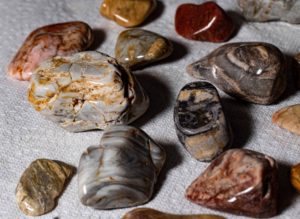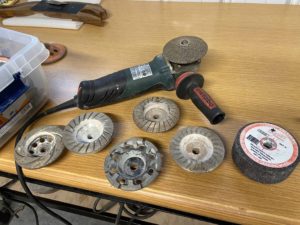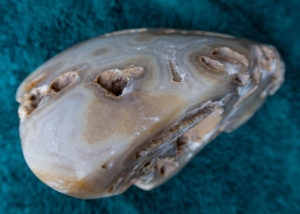There are so many smart, interesting and kind-hearted people out there! They are everywhere and all you need to do is meet them, but how do you meet them? My friend Dahven has a rule. She assumes that even at a drab party, there is someone else there who has a good story. Dahven reminds herself that she will inevitably come away from every party enriched. She only needs to start her treasure hunt to find that person and to hear that story. She tells me that she has never been disappointed.
But some of us struggle with the task of walking up to talk with strangers. Journalist Kio Stark has made a career out of urging people to talk with strangers and her best technique is triangulation. Simply put, rather than walking up to directly talk to a stranger, identify some interest that you might have in common to talk about, such as the stranger’s dog or a book they are reading. Stark’s TED talk is well worth watching (see also, James Hamblin’s video at The Atlantic–a controlled study in triangulation).
I’ve was reminded how powerful triangulation can be. I’ve recently rekindled a childhood passion: rockhounding. Most people love beautiful rocks and they serve well as objects for triangulation. I recently finished tumbling my first batch of rocks from Missouri creeks. Almost without fail, when I show these smooth colorful tumbled rocks to others, this results in smiles and good conversation. I’ve seen it over. I love rocks, other people tend to love rocks, and I really enjoy getting to know new people. It’s a winning combination. Rocks are powerful catalysts for social interactions. Here are three quick examples.
#1: After posting my photos of tumbled rocks on FB, I was PM’d by a woman  named Patti Kemper, who asked for my house address. Why? She explained that she saw how much I enjoyed rocks and she wanted to send me some exotic rocks that she had found near her home in Las Vegas. A few days later a big box of beautiful rocks, including some raw chalcedony. Wow! Why did Patti send these to me? Because she was delighted to see on FB that I was so excited about tumbled rocks. I’ve also seen this at FB rockhounds groups, where members share in each others’ discoveries and offer each other advice how to identify rocks and where to find new rocks.
named Patti Kemper, who asked for my house address. Why? She explained that she saw how much I enjoyed rocks and she wanted to send me some exotic rocks that she had found near her home in Las Vegas. A few days later a big box of beautiful rocks, including some raw chalcedony. Wow! Why did Patti send these to me? Because she was delighted to see on FB that I was so excited about tumbled rocks. I’ve also seen this at FB rockhounds groups, where members share in each others’ discoveries and offer each other advice how to identify rocks and where to find new rocks.
#2. A woman named Angela Knight also noticed my photo of tumbled rocks. That led to further messages and then a phone call with her husband Bill, a man who has created some exquisite sculptures of Missouri rocks that he found in S.E. Missouri. He invited me down to work side by side with him using angle grinders,  diamond bits, polishing stones and the other specialized equipment necessary to cut and polish rocks. Bill has a passion for the beauty of the rocks themselves, the aesthetics of shaping them, the technical challenges of shaping them, the thrill of locating them and the philosophical discussions one tends to have when one works on a rock for hours at a time, and that includes our spontaneous discussion of J.J. Gibson’s theory of affordances from his 1979 work, he Ecological Approach to Visual Perception. Rocks and philosophy go together very nicely, it seems. I’ve been down to Bill’s place twice now and I consider him a friend.
diamond bits, polishing stones and the other specialized equipment necessary to cut and polish rocks. Bill has a passion for the beauty of the rocks themselves, the aesthetics of shaping them, the technical challenges of shaping them, the thrill of locating them and the philosophical discussions one tends to have when one works on a rock for hours at a time, and that includes our spontaneous discussion of J.J. Gibson’s theory of affordances from his 1979 work, he Ecological Approach to Visual Perception. Rocks and philosophy go together very nicely, it seems. I’ve been down to Bill’s place twice now and I consider him a friend.
Some would consider sculpting large rocks to be loud and nasty work because you need special respiration filters, hearing protection and eye protection. But the process is actually blissful and I have so very much enjoyed learning under Bill’s wing. I’ve recently finished my first work. It’s a four-sided piece (three flat and one long curve) of either quartz or onyx. It’s an enigmatic shape that includes natural indents, including two that go completely through the rock. The polishing has brought out beautiful textures that weren’t apparent
 in the raw rock, which I found in a Missouri creek. Working hard on sculpting the rocks is a magically peaceful endeavor, where words tend to disappear from my inner thought process, and where the boundary between rock and sculptor almost seems alive. Why did Bill reach out and offer so much of his time and expertise to guide me? He told me that it was because I showed such enthusiasm.
in the raw rock, which I found in a Missouri creek. Working hard on sculpting the rocks is a magically peaceful endeavor, where words tend to disappear from my inner thought process, and where the boundary between rock and sculptor almost seems alive. Why did Bill reach out and offer so much of his time and expertise to guide me? He told me that it was because I showed such enthusiasm.
#3. Two weeks ago, a friend of mine came over to my house to see my rock tumbler and she lit up. She now has her own rock tumbler. We are about to take a journey to southeast Missouri to find rocks for our tumblers. Why am I reaching out to share my new knowledge? Because of her enthusiasm.
I’m posting some photos along with this post, to make these stories more vivid.
My friend John Simon often says, “It’s all about relationships,” and that is often so true. I thought I was excited about the rocks themselves. I thought I was energized by a new a hobby, by the adventures of locating them, the process of turning them into art and by the chance to learn new skills to do this. The best part of this process, though, has been connecting with smart and kind-hearted people to learn these new skills and to share these adventures.
The rock, like so many other “things,” can be a magic object of triangulation. A rock can be a seed for friendship.





